Logistics and Supply Chain Management
VerifiedAdded on 2020/05/16
|14
|3355
|65
AI Summary
This assignment requires a thorough analysis of the provided research papers on various facets of logistics and supply chain management. Students must critically evaluate these academic sources, synthesizing their findings to understand current trends, challenges, and future directions within the field. The focus encompasses topics such as part logistics in automotive industries, vehicle routing problems, green logistics, facility layout optimization, big data applications, and the evolving role of technology in supply chain management.
Contribute Materials
Your contribution can guide someone’s learning journey. Share your
documents today.
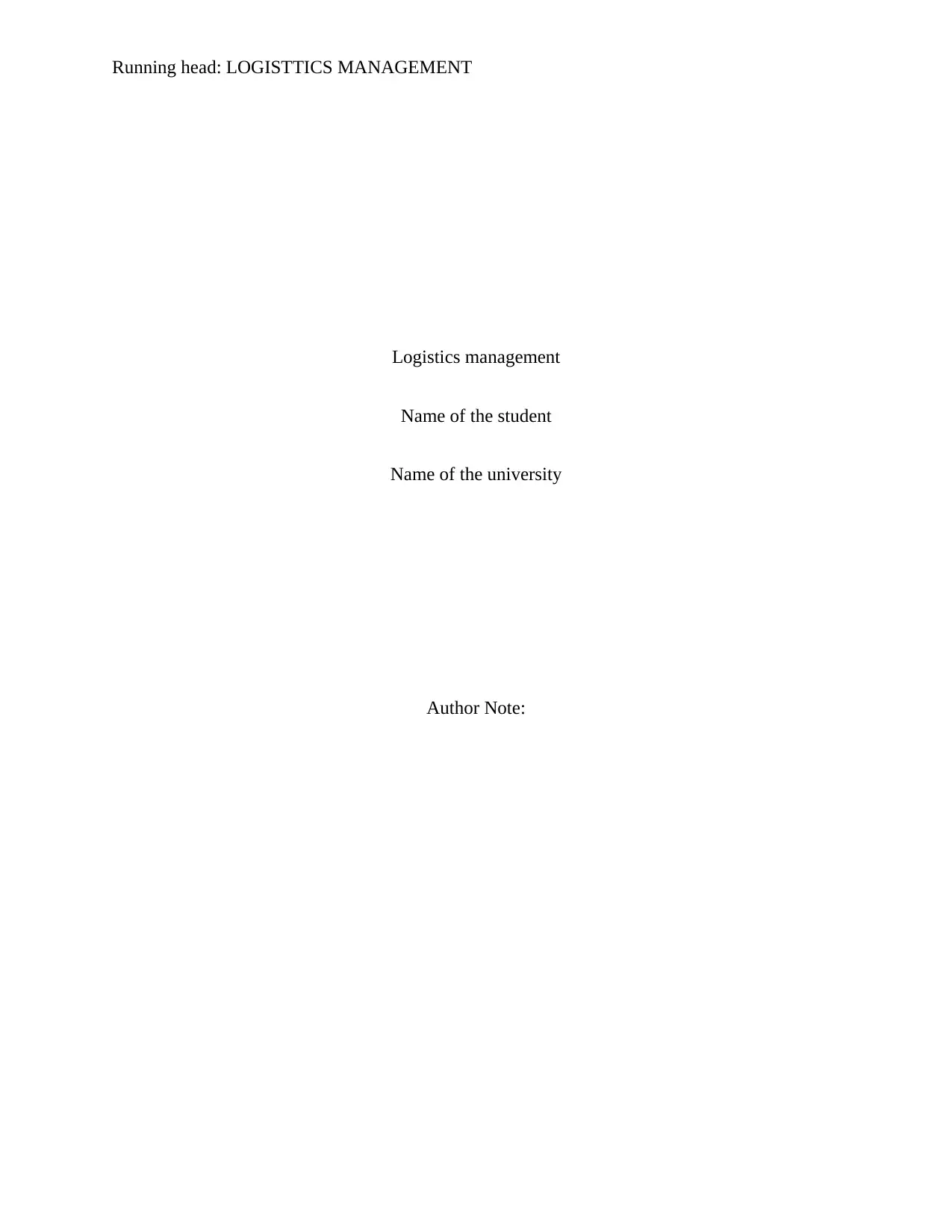
Running head: LOGISTTICS MANAGEMENT
Logistics management
Name of the student
Name of the university
Author Note:
Logistics management
Name of the student
Name of the university
Author Note:
Secure Best Marks with AI Grader
Need help grading? Try our AI Grader for instant feedback on your assignments.
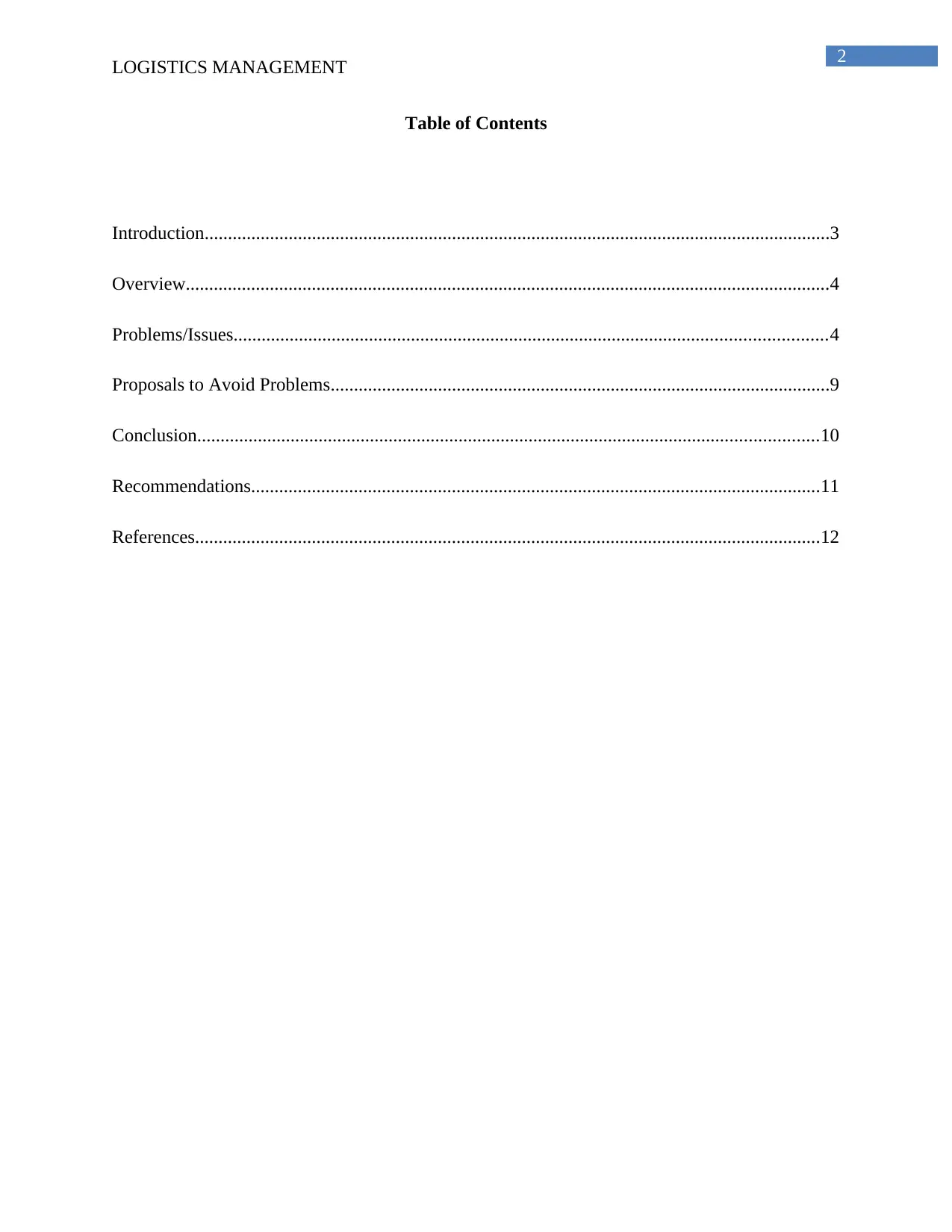
2
LOGISTICS MANAGEMENT
Table of Contents
Introduction......................................................................................................................................3
Overview..........................................................................................................................................4
Problems/Issues...............................................................................................................................4
Proposals to Avoid Problems...........................................................................................................9
Conclusion.....................................................................................................................................10
Recommendations..........................................................................................................................11
References......................................................................................................................................12
LOGISTICS MANAGEMENT
Table of Contents
Introduction......................................................................................................................................3
Overview..........................................................................................................................................4
Problems/Issues...............................................................................................................................4
Proposals to Avoid Problems...........................................................................................................9
Conclusion.....................................................................................................................................10
Recommendations..........................................................................................................................11
References......................................................................................................................................12
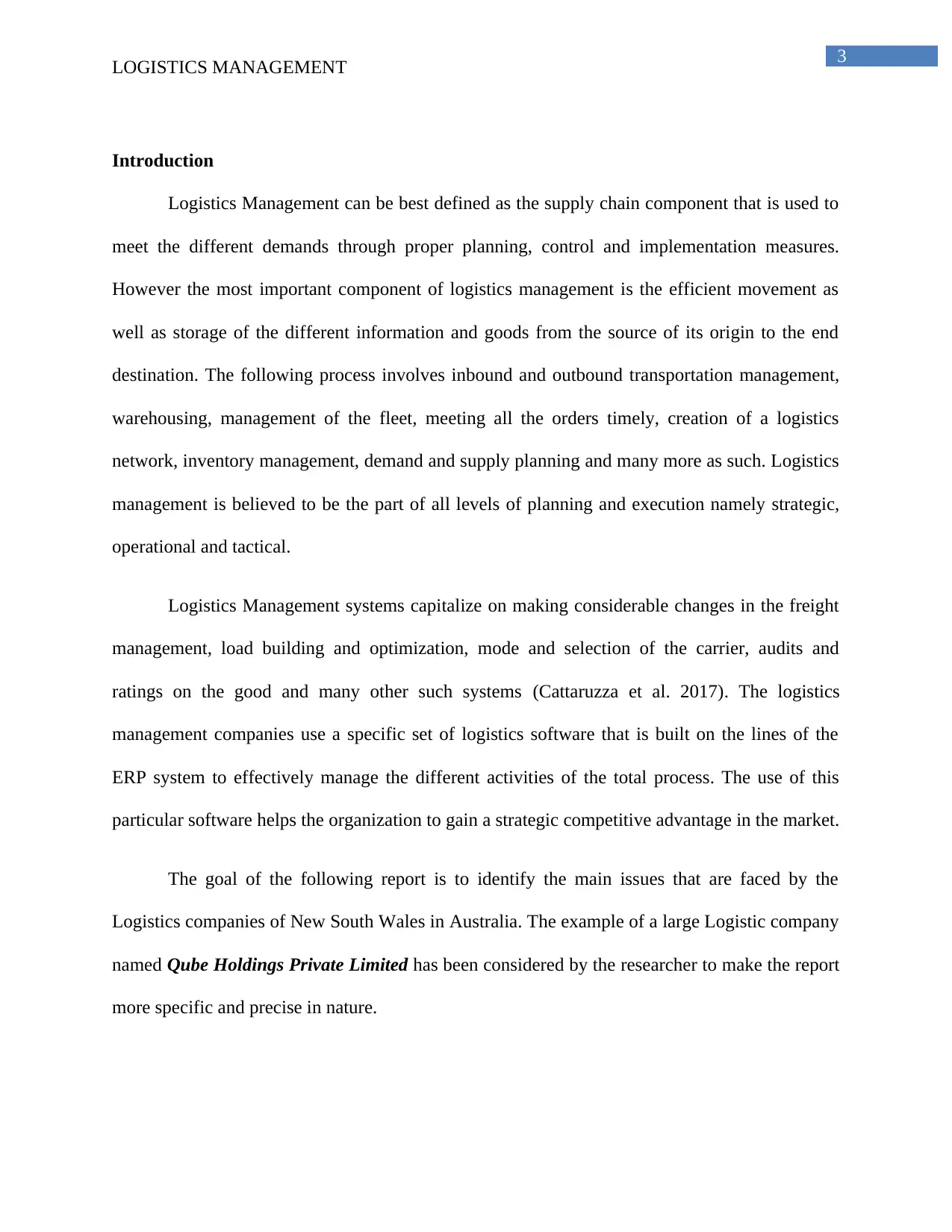
3
LOGISTICS MANAGEMENT
Introduction
Logistics Management can be best defined as the supply chain component that is used to
meet the different demands through proper planning, control and implementation measures.
However the most important component of logistics management is the efficient movement as
well as storage of the different information and goods from the source of its origin to the end
destination. The following process involves inbound and outbound transportation management,
warehousing, management of the fleet, meeting all the orders timely, creation of a logistics
network, inventory management, demand and supply planning and many more as such. Logistics
management is believed to be the part of all levels of planning and execution namely strategic,
operational and tactical.
Logistics Management systems capitalize on making considerable changes in the freight
management, load building and optimization, mode and selection of the carrier, audits and
ratings on the good and many other such systems (Cattaruzza et al. 2017). The logistics
management companies use a specific set of logistics software that is built on the lines of the
ERP system to effectively manage the different activities of the total process. The use of this
particular software helps the organization to gain a strategic competitive advantage in the market.
The goal of the following report is to identify the main issues that are faced by the
Logistics companies of New South Wales in Australia. The example of a large Logistic company
named Qube Holdings Private Limited has been considered by the researcher to make the report
more specific and precise in nature.
LOGISTICS MANAGEMENT
Introduction
Logistics Management can be best defined as the supply chain component that is used to
meet the different demands through proper planning, control and implementation measures.
However the most important component of logistics management is the efficient movement as
well as storage of the different information and goods from the source of its origin to the end
destination. The following process involves inbound and outbound transportation management,
warehousing, management of the fleet, meeting all the orders timely, creation of a logistics
network, inventory management, demand and supply planning and many more as such. Logistics
management is believed to be the part of all levels of planning and execution namely strategic,
operational and tactical.
Logistics Management systems capitalize on making considerable changes in the freight
management, load building and optimization, mode and selection of the carrier, audits and
ratings on the good and many other such systems (Cattaruzza et al. 2017). The logistics
management companies use a specific set of logistics software that is built on the lines of the
ERP system to effectively manage the different activities of the total process. The use of this
particular software helps the organization to gain a strategic competitive advantage in the market.
The goal of the following report is to identify the main issues that are faced by the
Logistics companies of New South Wales in Australia. The example of a large Logistic company
named Qube Holdings Private Limited has been considered by the researcher to make the report
more specific and precise in nature.
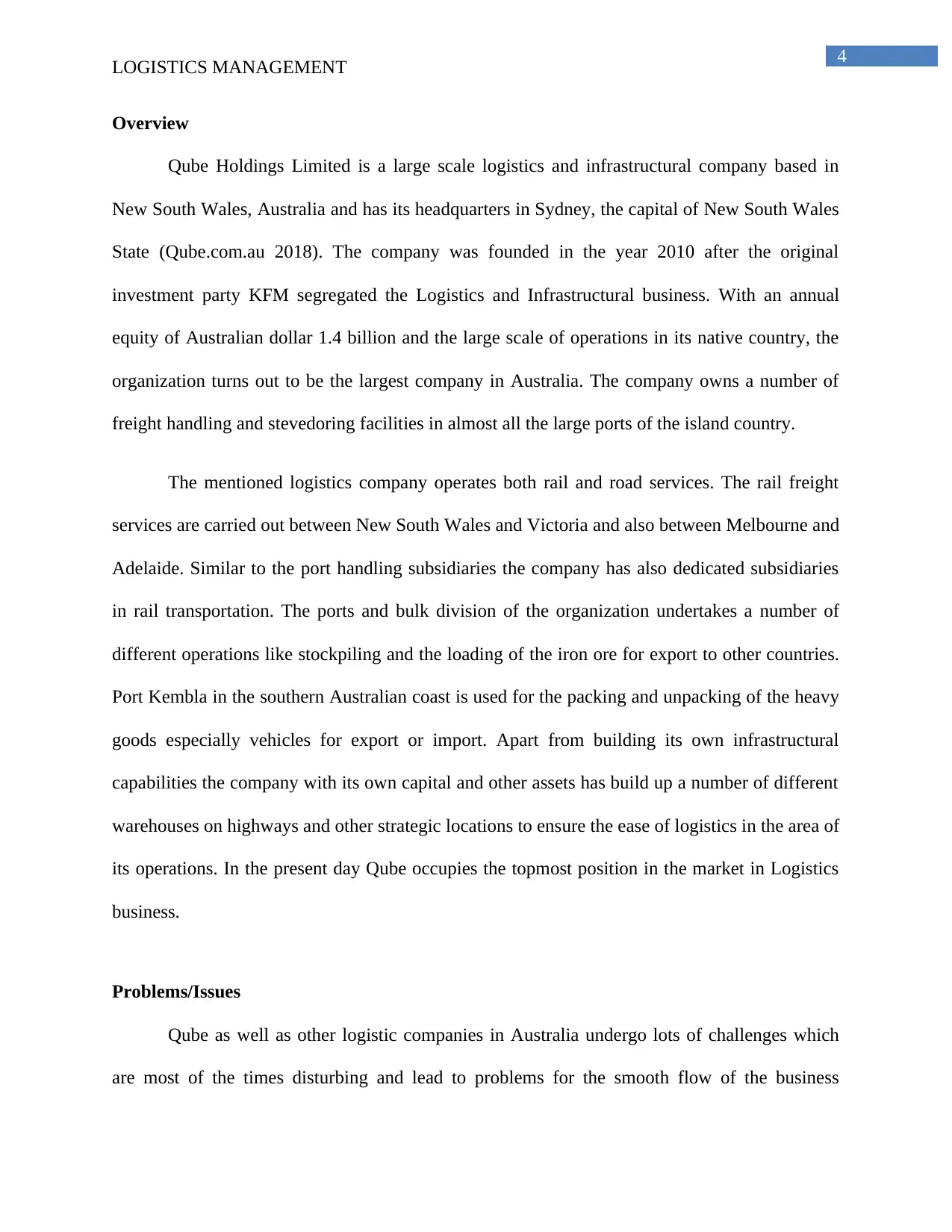
4
LOGISTICS MANAGEMENT
Overview
Qube Holdings Limited is a large scale logistics and infrastructural company based in
New South Wales, Australia and has its headquarters in Sydney, the capital of New South Wales
State (Qube.com.au 2018). The company was founded in the year 2010 after the original
investment party KFM segregated the Logistics and Infrastructural business. With an annual
equity of Australian dollar 1.4 billion and the large scale of operations in its native country, the
organization turns out to be the largest company in Australia. The company owns a number of
freight handling and stevedoring facilities in almost all the large ports of the island country.
The mentioned logistics company operates both rail and road services. The rail freight
services are carried out between New South Wales and Victoria and also between Melbourne and
Adelaide. Similar to the port handling subsidiaries the company has also dedicated subsidiaries
in rail transportation. The ports and bulk division of the organization undertakes a number of
different operations like stockpiling and the loading of the iron ore for export to other countries.
Port Kembla in the southern Australian coast is used for the packing and unpacking of the heavy
goods especially vehicles for export or import. Apart from building its own infrastructural
capabilities the company with its own capital and other assets has build up a number of different
warehouses on highways and other strategic locations to ensure the ease of logistics in the area of
its operations. In the present day Qube occupies the topmost position in the market in Logistics
business.
Problems/Issues
Qube as well as other logistic companies in Australia undergo lots of challenges which
are most of the times disturbing and lead to problems for the smooth flow of the business
LOGISTICS MANAGEMENT
Overview
Qube Holdings Limited is a large scale logistics and infrastructural company based in
New South Wales, Australia and has its headquarters in Sydney, the capital of New South Wales
State (Qube.com.au 2018). The company was founded in the year 2010 after the original
investment party KFM segregated the Logistics and Infrastructural business. With an annual
equity of Australian dollar 1.4 billion and the large scale of operations in its native country, the
organization turns out to be the largest company in Australia. The company owns a number of
freight handling and stevedoring facilities in almost all the large ports of the island country.
The mentioned logistics company operates both rail and road services. The rail freight
services are carried out between New South Wales and Victoria and also between Melbourne and
Adelaide. Similar to the port handling subsidiaries the company has also dedicated subsidiaries
in rail transportation. The ports and bulk division of the organization undertakes a number of
different operations like stockpiling and the loading of the iron ore for export to other countries.
Port Kembla in the southern Australian coast is used for the packing and unpacking of the heavy
goods especially vehicles for export or import. Apart from building its own infrastructural
capabilities the company with its own capital and other assets has build up a number of different
warehouses on highways and other strategic locations to ensure the ease of logistics in the area of
its operations. In the present day Qube occupies the topmost position in the market in Logistics
business.
Problems/Issues
Qube as well as other logistic companies in Australia undergo lots of challenges which
are most of the times disturbing and lead to problems for the smooth flow of the business
Secure Best Marks with AI Grader
Need help grading? Try our AI Grader for instant feedback on your assignments.
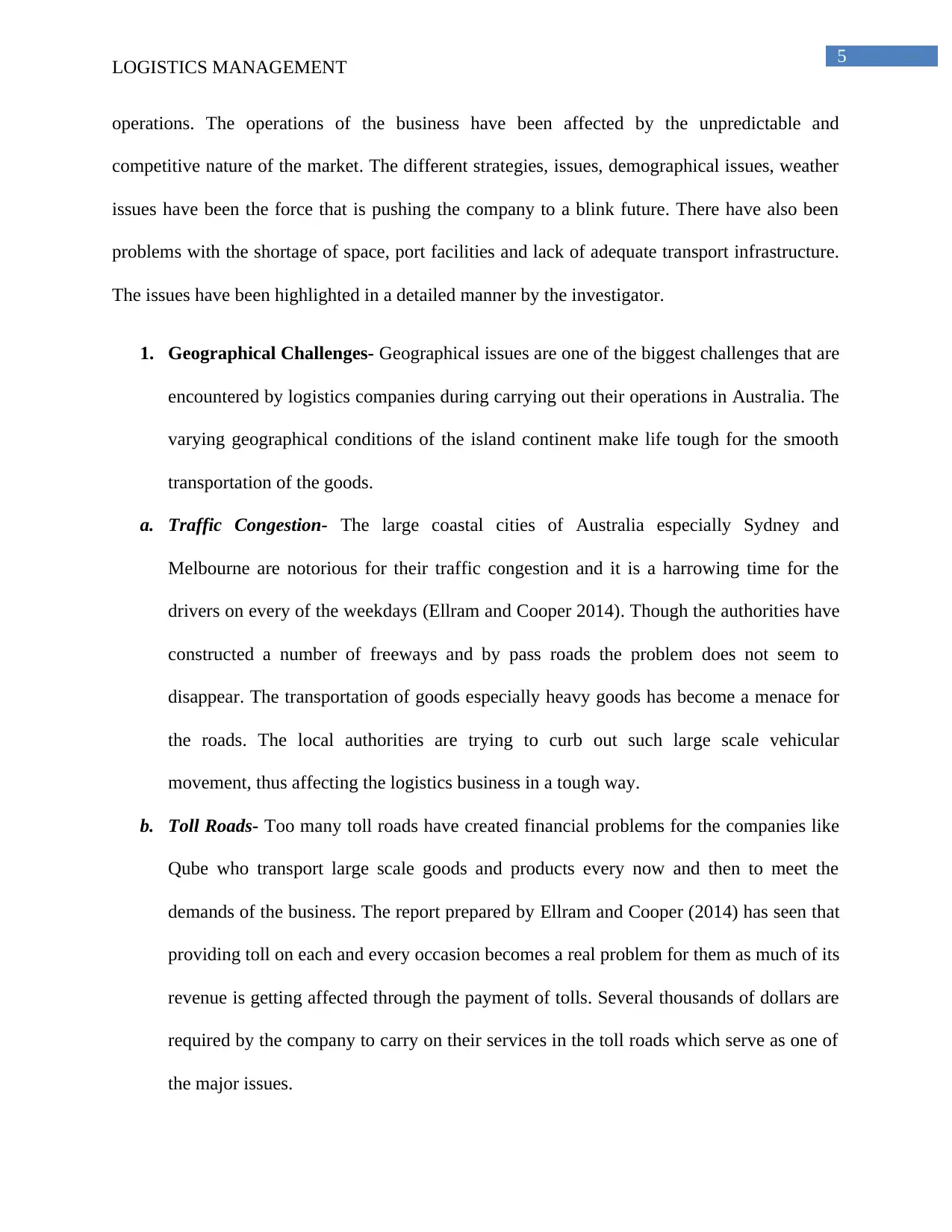
5
LOGISTICS MANAGEMENT
operations. The operations of the business have been affected by the unpredictable and
competitive nature of the market. The different strategies, issues, demographical issues, weather
issues have been the force that is pushing the company to a blink future. There have also been
problems with the shortage of space, port facilities and lack of adequate transport infrastructure.
The issues have been highlighted in a detailed manner by the investigator.
1. Geographical Challenges- Geographical issues are one of the biggest challenges that are
encountered by logistics companies during carrying out their operations in Australia. The
varying geographical conditions of the island continent make life tough for the smooth
transportation of the goods.
a. Traffic Congestion- The large coastal cities of Australia especially Sydney and
Melbourne are notorious for their traffic congestion and it is a harrowing time for the
drivers on every of the weekdays (Ellram and Cooper 2014). Though the authorities have
constructed a number of freeways and by pass roads the problem does not seem to
disappear. The transportation of goods especially heavy goods has become a menace for
the roads. The local authorities are trying to curb out such large scale vehicular
movement, thus affecting the logistics business in a tough way.
b. Toll Roads- Too many toll roads have created financial problems for the companies like
Qube who transport large scale goods and products every now and then to meet the
demands of the business. The report prepared by Ellram and Cooper (2014) has seen that
providing toll on each and every occasion becomes a real problem for them as much of its
revenue is getting affected through the payment of tolls. Several thousands of dollars are
required by the company to carry on their services in the toll roads which serve as one of
the major issues.
LOGISTICS MANAGEMENT
operations. The operations of the business have been affected by the unpredictable and
competitive nature of the market. The different strategies, issues, demographical issues, weather
issues have been the force that is pushing the company to a blink future. There have also been
problems with the shortage of space, port facilities and lack of adequate transport infrastructure.
The issues have been highlighted in a detailed manner by the investigator.
1. Geographical Challenges- Geographical issues are one of the biggest challenges that are
encountered by logistics companies during carrying out their operations in Australia. The
varying geographical conditions of the island continent make life tough for the smooth
transportation of the goods.
a. Traffic Congestion- The large coastal cities of Australia especially Sydney and
Melbourne are notorious for their traffic congestion and it is a harrowing time for the
drivers on every of the weekdays (Ellram and Cooper 2014). Though the authorities have
constructed a number of freeways and by pass roads the problem does not seem to
disappear. The transportation of goods especially heavy goods has become a menace for
the roads. The local authorities are trying to curb out such large scale vehicular
movement, thus affecting the logistics business in a tough way.
b. Toll Roads- Too many toll roads have created financial problems for the companies like
Qube who transport large scale goods and products every now and then to meet the
demands of the business. The report prepared by Ellram and Cooper (2014) has seen that
providing toll on each and every occasion becomes a real problem for them as much of its
revenue is getting affected through the payment of tolls. Several thousands of dollars are
required by the company to carry on their services in the toll roads which serve as one of
the major issues.
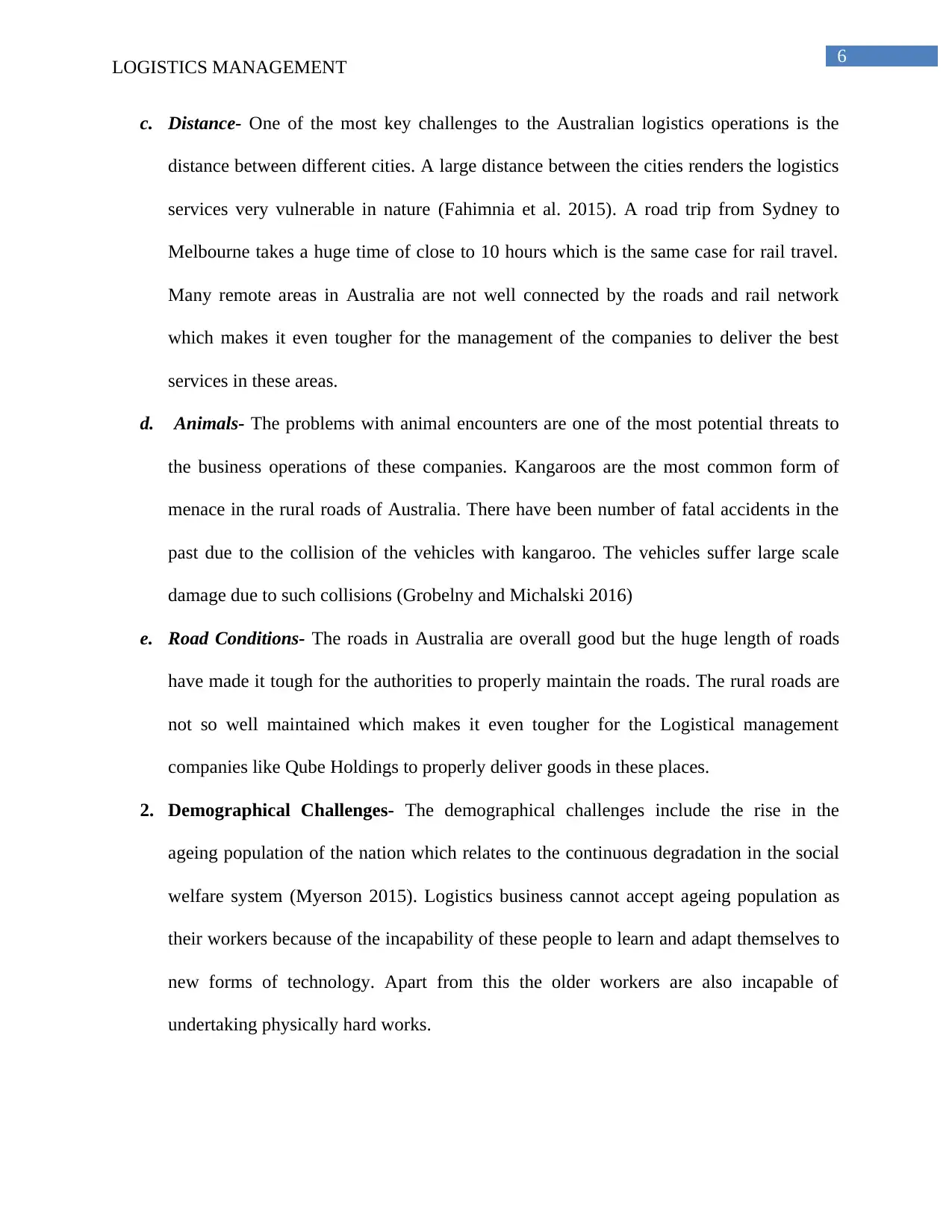
6
LOGISTICS MANAGEMENT
c. Distance- One of the most key challenges to the Australian logistics operations is the
distance between different cities. A large distance between the cities renders the logistics
services very vulnerable in nature (Fahimnia et al. 2015). A road trip from Sydney to
Melbourne takes a huge time of close to 10 hours which is the same case for rail travel.
Many remote areas in Australia are not well connected by the roads and rail network
which makes it even tougher for the management of the companies to deliver the best
services in these areas.
d. Animals- The problems with animal encounters are one of the most potential threats to
the business operations of these companies. Kangaroos are the most common form of
menace in the rural roads of Australia. There have been number of fatal accidents in the
past due to the collision of the vehicles with kangaroo. The vehicles suffer large scale
damage due to such collisions (Grobelny and Michalski 2016)
e. Road Conditions- The roads in Australia are overall good but the huge length of roads
have made it tough for the authorities to properly maintain the roads. The rural roads are
not so well maintained which makes it even tougher for the Logistical management
companies like Qube Holdings to properly deliver goods in these places.
2. Demographical Challenges- The demographical challenges include the rise in the
ageing population of the nation which relates to the continuous degradation in the social
welfare system (Myerson 2015). Logistics business cannot accept ageing population as
their workers because of the incapability of these people to learn and adapt themselves to
new forms of technology. Apart from this the older workers are also incapable of
undertaking physically hard works.
LOGISTICS MANAGEMENT
c. Distance- One of the most key challenges to the Australian logistics operations is the
distance between different cities. A large distance between the cities renders the logistics
services very vulnerable in nature (Fahimnia et al. 2015). A road trip from Sydney to
Melbourne takes a huge time of close to 10 hours which is the same case for rail travel.
Many remote areas in Australia are not well connected by the roads and rail network
which makes it even tougher for the management of the companies to deliver the best
services in these areas.
d. Animals- The problems with animal encounters are one of the most potential threats to
the business operations of these companies. Kangaroos are the most common form of
menace in the rural roads of Australia. There have been number of fatal accidents in the
past due to the collision of the vehicles with kangaroo. The vehicles suffer large scale
damage due to such collisions (Grobelny and Michalski 2016)
e. Road Conditions- The roads in Australia are overall good but the huge length of roads
have made it tough for the authorities to properly maintain the roads. The rural roads are
not so well maintained which makes it even tougher for the Logistical management
companies like Qube Holdings to properly deliver goods in these places.
2. Demographical Challenges- The demographical challenges include the rise in the
ageing population of the nation which relates to the continuous degradation in the social
welfare system (Myerson 2015). Logistics business cannot accept ageing population as
their workers because of the incapability of these people to learn and adapt themselves to
new forms of technology. Apart from this the older workers are also incapable of
undertaking physically hard works.
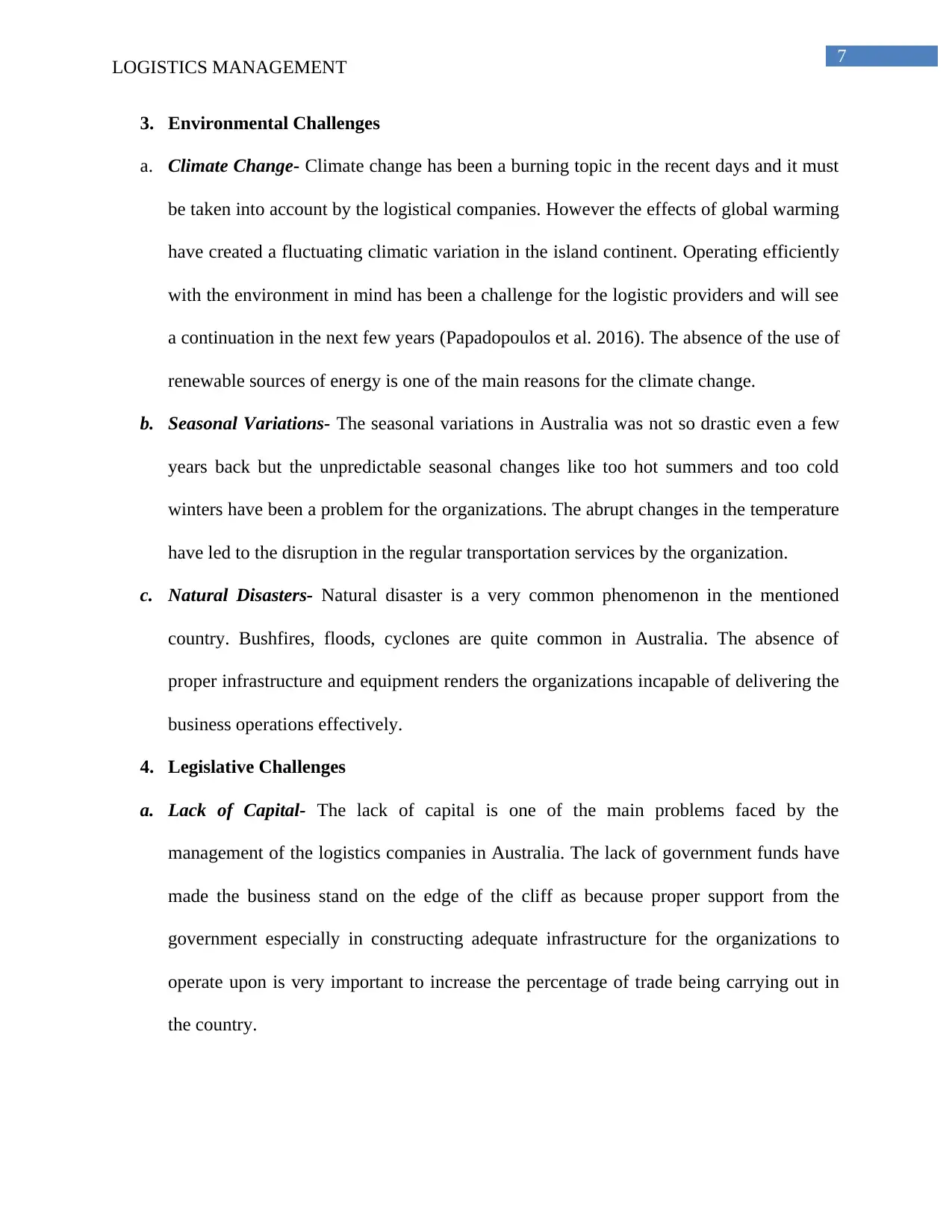
7
LOGISTICS MANAGEMENT
3. Environmental Challenges
a. Climate Change- Climate change has been a burning topic in the recent days and it must
be taken into account by the logistical companies. However the effects of global warming
have created a fluctuating climatic variation in the island continent. Operating efficiently
with the environment in mind has been a challenge for the logistic providers and will see
a continuation in the next few years (Papadopoulos et al. 2016). The absence of the use of
renewable sources of energy is one of the main reasons for the climate change.
b. Seasonal Variations- The seasonal variations in Australia was not so drastic even a few
years back but the unpredictable seasonal changes like too hot summers and too cold
winters have been a problem for the organizations. The abrupt changes in the temperature
have led to the disruption in the regular transportation services by the organization.
c. Natural Disasters- Natural disaster is a very common phenomenon in the mentioned
country. Bushfires, floods, cyclones are quite common in Australia. The absence of
proper infrastructure and equipment renders the organizations incapable of delivering the
business operations effectively.
4. Legislative Challenges
a. Lack of Capital- The lack of capital is one of the main problems faced by the
management of the logistics companies in Australia. The lack of government funds have
made the business stand on the edge of the cliff as because proper support from the
government especially in constructing adequate infrastructure for the organizations to
operate upon is very important to increase the percentage of trade being carrying out in
the country.
LOGISTICS MANAGEMENT
3. Environmental Challenges
a. Climate Change- Climate change has been a burning topic in the recent days and it must
be taken into account by the logistical companies. However the effects of global warming
have created a fluctuating climatic variation in the island continent. Operating efficiently
with the environment in mind has been a challenge for the logistic providers and will see
a continuation in the next few years (Papadopoulos et al. 2016). The absence of the use of
renewable sources of energy is one of the main reasons for the climate change.
b. Seasonal Variations- The seasonal variations in Australia was not so drastic even a few
years back but the unpredictable seasonal changes like too hot summers and too cold
winters have been a problem for the organizations. The abrupt changes in the temperature
have led to the disruption in the regular transportation services by the organization.
c. Natural Disasters- Natural disaster is a very common phenomenon in the mentioned
country. Bushfires, floods, cyclones are quite common in Australia. The absence of
proper infrastructure and equipment renders the organizations incapable of delivering the
business operations effectively.
4. Legislative Challenges
a. Lack of Capital- The lack of capital is one of the main problems faced by the
management of the logistics companies in Australia. The lack of government funds have
made the business stand on the edge of the cliff as because proper support from the
government especially in constructing adequate infrastructure for the organizations to
operate upon is very important to increase the percentage of trade being carrying out in
the country.
Paraphrase This Document
Need a fresh take? Get an instant paraphrase of this document with our AI Paraphraser
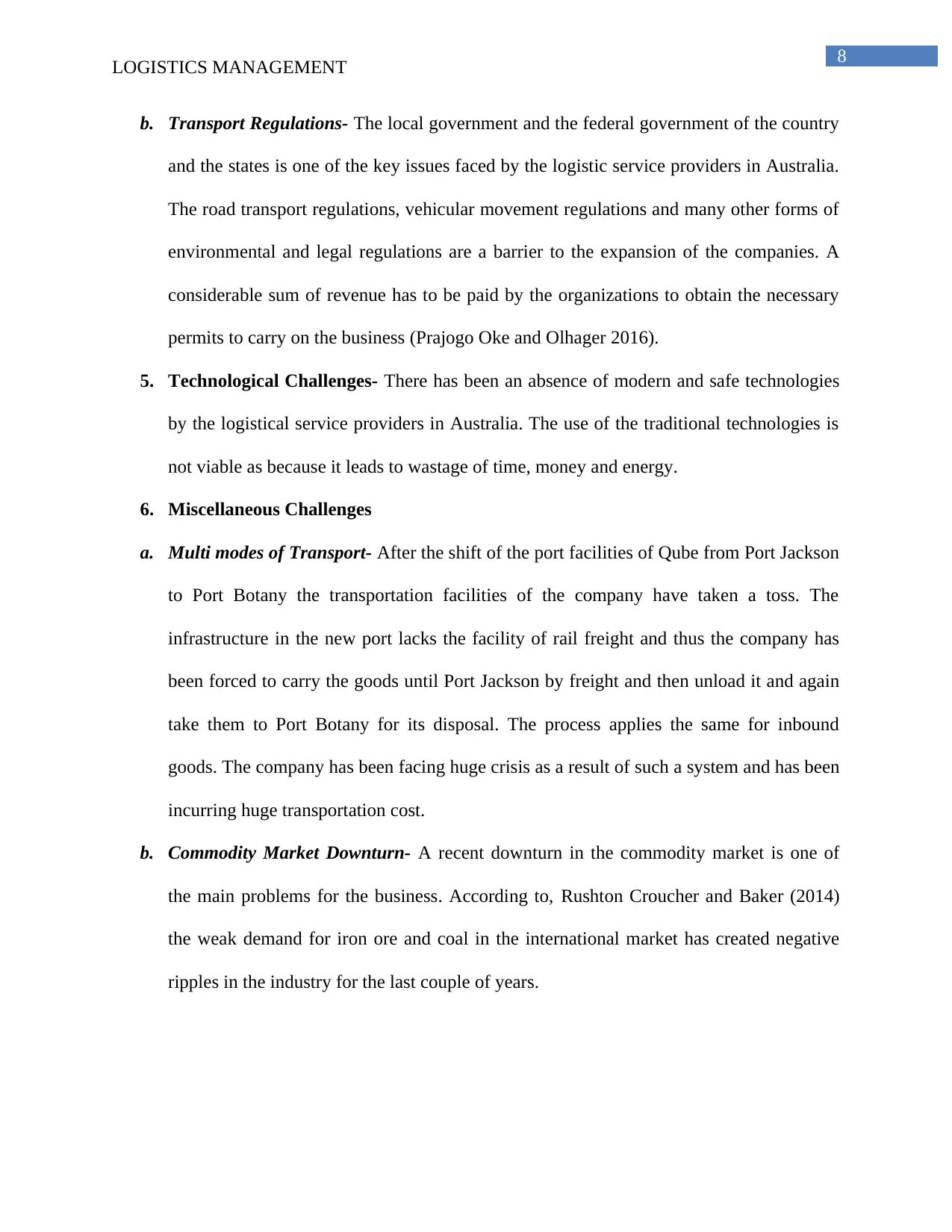
8
LOGISTICS MANAGEMENT
b. Transport Regulations- The local government and the federal government of the country
and the states is one of the key issues faced by the logistic service providers in Australia.
The road transport regulations, vehicular movement regulations and many other forms of
environmental and legal regulations are a barrier to the expansion of the companies. A
considerable sum of revenue has to be paid by the organizations to obtain the necessary
permits to carry on the business (Prajogo Oke and Olhager 2016).
5. Technological Challenges- There has been an absence of modern and safe technologies
by the logistical service providers in Australia. The use of the traditional technologies is
not viable as because it leads to wastage of time, money and energy.
6. Miscellaneous Challenges
a. Multi modes of Transport- After the shift of the port facilities of Qube from Port Jackson
to Port Botany the transportation facilities of the company have taken a toss. The
infrastructure in the new port lacks the facility of rail freight and thus the company has
been forced to carry the goods until Port Jackson by freight and then unload it and again
take them to Port Botany for its disposal. The process applies the same for inbound
goods. The company has been facing huge crisis as a result of such a system and has been
incurring huge transportation cost.
b. Commodity Market Downturn- A recent downturn in the commodity market is one of
the main problems for the business. According to, Rushton Croucher and Baker (2014)
the weak demand for iron ore and coal in the international market has created negative
ripples in the industry for the last couple of years.
LOGISTICS MANAGEMENT
b. Transport Regulations- The local government and the federal government of the country
and the states is one of the key issues faced by the logistic service providers in Australia.
The road transport regulations, vehicular movement regulations and many other forms of
environmental and legal regulations are a barrier to the expansion of the companies. A
considerable sum of revenue has to be paid by the organizations to obtain the necessary
permits to carry on the business (Prajogo Oke and Olhager 2016).
5. Technological Challenges- There has been an absence of modern and safe technologies
by the logistical service providers in Australia. The use of the traditional technologies is
not viable as because it leads to wastage of time, money and energy.
6. Miscellaneous Challenges
a. Multi modes of Transport- After the shift of the port facilities of Qube from Port Jackson
to Port Botany the transportation facilities of the company have taken a toss. The
infrastructure in the new port lacks the facility of rail freight and thus the company has
been forced to carry the goods until Port Jackson by freight and then unload it and again
take them to Port Botany for its disposal. The process applies the same for inbound
goods. The company has been facing huge crisis as a result of such a system and has been
incurring huge transportation cost.
b. Commodity Market Downturn- A recent downturn in the commodity market is one of
the main problems for the business. According to, Rushton Croucher and Baker (2014)
the weak demand for iron ore and coal in the international market has created negative
ripples in the industry for the last couple of years.
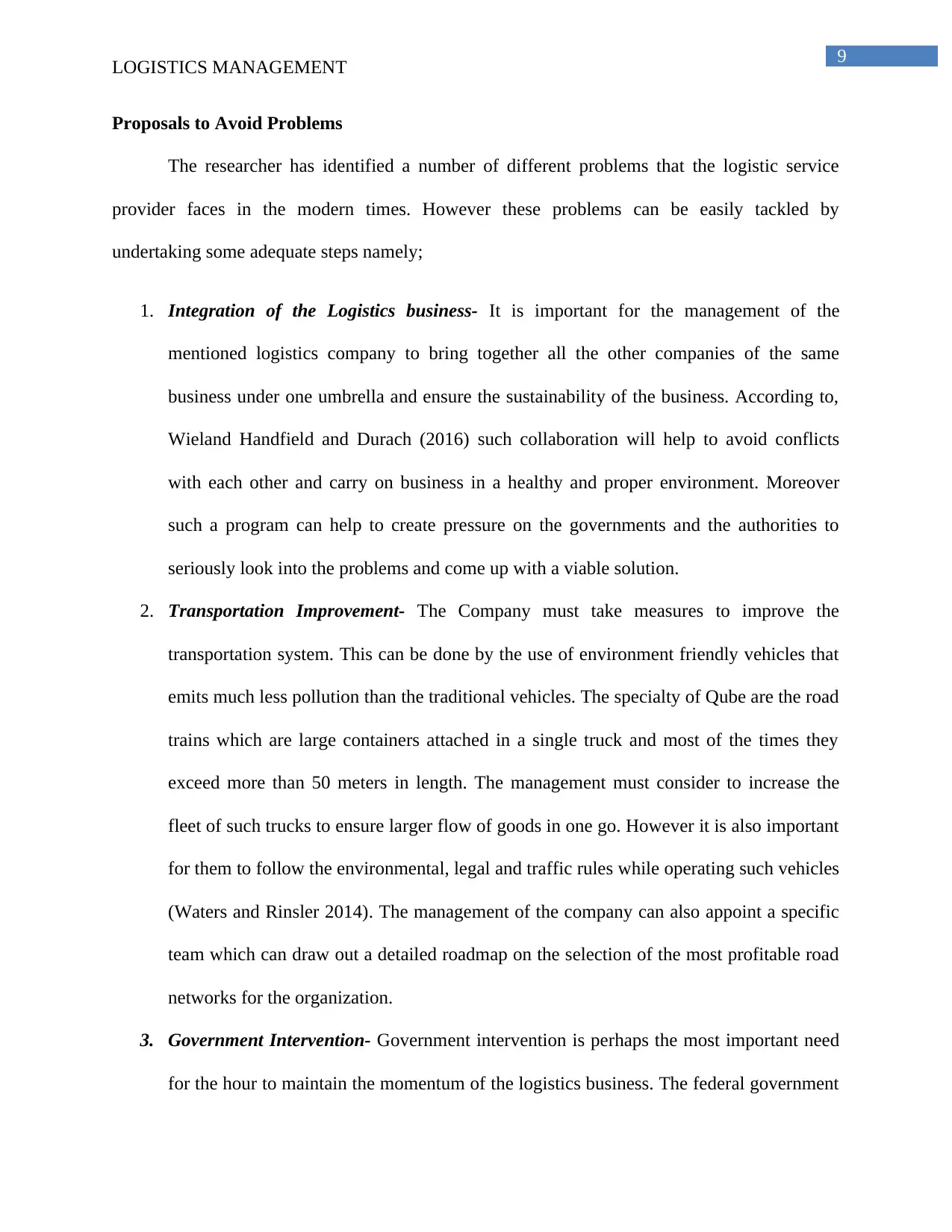
9
LOGISTICS MANAGEMENT
Proposals to Avoid Problems
The researcher has identified a number of different problems that the logistic service
provider faces in the modern times. However these problems can be easily tackled by
undertaking some adequate steps namely;
1. Integration of the Logistics business- It is important for the management of the
mentioned logistics company to bring together all the other companies of the same
business under one umbrella and ensure the sustainability of the business. According to,
Wieland Handfield and Durach (2016) such collaboration will help to avoid conflicts
with each other and carry on business in a healthy and proper environment. Moreover
such a program can help to create pressure on the governments and the authorities to
seriously look into the problems and come up with a viable solution.
2. Transportation Improvement- The Company must take measures to improve the
transportation system. This can be done by the use of environment friendly vehicles that
emits much less pollution than the traditional vehicles. The specialty of Qube are the road
trains which are large containers attached in a single truck and most of the times they
exceed more than 50 meters in length. The management must consider to increase the
fleet of such trucks to ensure larger flow of goods in one go. However it is also important
for them to follow the environmental, legal and traffic rules while operating such vehicles
(Waters and Rinsler 2014). The management of the company can also appoint a specific
team which can draw out a detailed roadmap on the selection of the most profitable road
networks for the organization.
3. Government Intervention- Government intervention is perhaps the most important need
for the hour to maintain the momentum of the logistics business. The federal government
LOGISTICS MANAGEMENT
Proposals to Avoid Problems
The researcher has identified a number of different problems that the logistic service
provider faces in the modern times. However these problems can be easily tackled by
undertaking some adequate steps namely;
1. Integration of the Logistics business- It is important for the management of the
mentioned logistics company to bring together all the other companies of the same
business under one umbrella and ensure the sustainability of the business. According to,
Wieland Handfield and Durach (2016) such collaboration will help to avoid conflicts
with each other and carry on business in a healthy and proper environment. Moreover
such a program can help to create pressure on the governments and the authorities to
seriously look into the problems and come up with a viable solution.
2. Transportation Improvement- The Company must take measures to improve the
transportation system. This can be done by the use of environment friendly vehicles that
emits much less pollution than the traditional vehicles. The specialty of Qube are the road
trains which are large containers attached in a single truck and most of the times they
exceed more than 50 meters in length. The management must consider to increase the
fleet of such trucks to ensure larger flow of goods in one go. However it is also important
for them to follow the environmental, legal and traffic rules while operating such vehicles
(Waters and Rinsler 2014). The management of the company can also appoint a specific
team which can draw out a detailed roadmap on the selection of the most profitable road
networks for the organization.
3. Government Intervention- Government intervention is perhaps the most important need
for the hour to maintain the momentum of the logistics business. The federal government
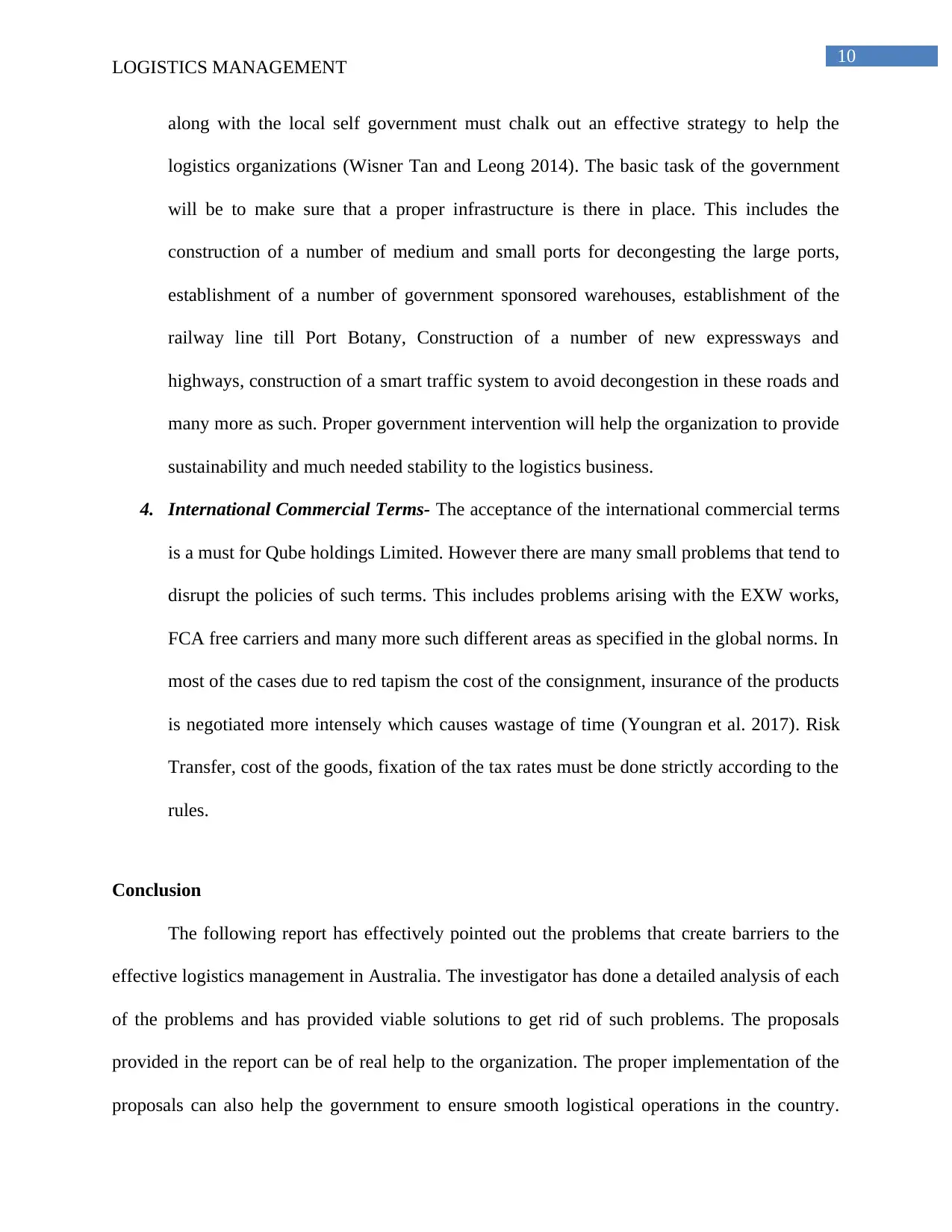
10
LOGISTICS MANAGEMENT
along with the local self government must chalk out an effective strategy to help the
logistics organizations (Wisner Tan and Leong 2014). The basic task of the government
will be to make sure that a proper infrastructure is there in place. This includes the
construction of a number of medium and small ports for decongesting the large ports,
establishment of a number of government sponsored warehouses, establishment of the
railway line till Port Botany, Construction of a number of new expressways and
highways, construction of a smart traffic system to avoid decongestion in these roads and
many more as such. Proper government intervention will help the organization to provide
sustainability and much needed stability to the logistics business.
4. International Commercial Terms- The acceptance of the international commercial terms
is a must for Qube holdings Limited. However there are many small problems that tend to
disrupt the policies of such terms. This includes problems arising with the EXW works,
FCA free carriers and many more such different areas as specified in the global norms. In
most of the cases due to red tapism the cost of the consignment, insurance of the products
is negotiated more intensely which causes wastage of time (Youngran et al. 2017). Risk
Transfer, cost of the goods, fixation of the tax rates must be done strictly according to the
rules.
Conclusion
The following report has effectively pointed out the problems that create barriers to the
effective logistics management in Australia. The investigator has done a detailed analysis of each
of the problems and has provided viable solutions to get rid of such problems. The proposals
provided in the report can be of real help to the organization. The proper implementation of the
proposals can also help the government to ensure smooth logistical operations in the country.
LOGISTICS MANAGEMENT
along with the local self government must chalk out an effective strategy to help the
logistics organizations (Wisner Tan and Leong 2014). The basic task of the government
will be to make sure that a proper infrastructure is there in place. This includes the
construction of a number of medium and small ports for decongesting the large ports,
establishment of a number of government sponsored warehouses, establishment of the
railway line till Port Botany, Construction of a number of new expressways and
highways, construction of a smart traffic system to avoid decongestion in these roads and
many more as such. Proper government intervention will help the organization to provide
sustainability and much needed stability to the logistics business.
4. International Commercial Terms- The acceptance of the international commercial terms
is a must for Qube holdings Limited. However there are many small problems that tend to
disrupt the policies of such terms. This includes problems arising with the EXW works,
FCA free carriers and many more such different areas as specified in the global norms. In
most of the cases due to red tapism the cost of the consignment, insurance of the products
is negotiated more intensely which causes wastage of time (Youngran et al. 2017). Risk
Transfer, cost of the goods, fixation of the tax rates must be done strictly according to the
rules.
Conclusion
The following report has effectively pointed out the problems that create barriers to the
effective logistics management in Australia. The investigator has done a detailed analysis of each
of the problems and has provided viable solutions to get rid of such problems. The proposals
provided in the report can be of real help to the organization. The proper implementation of the
proposals can also help the government to ensure smooth logistical operations in the country.
Secure Best Marks with AI Grader
Need help grading? Try our AI Grader for instant feedback on your assignments.
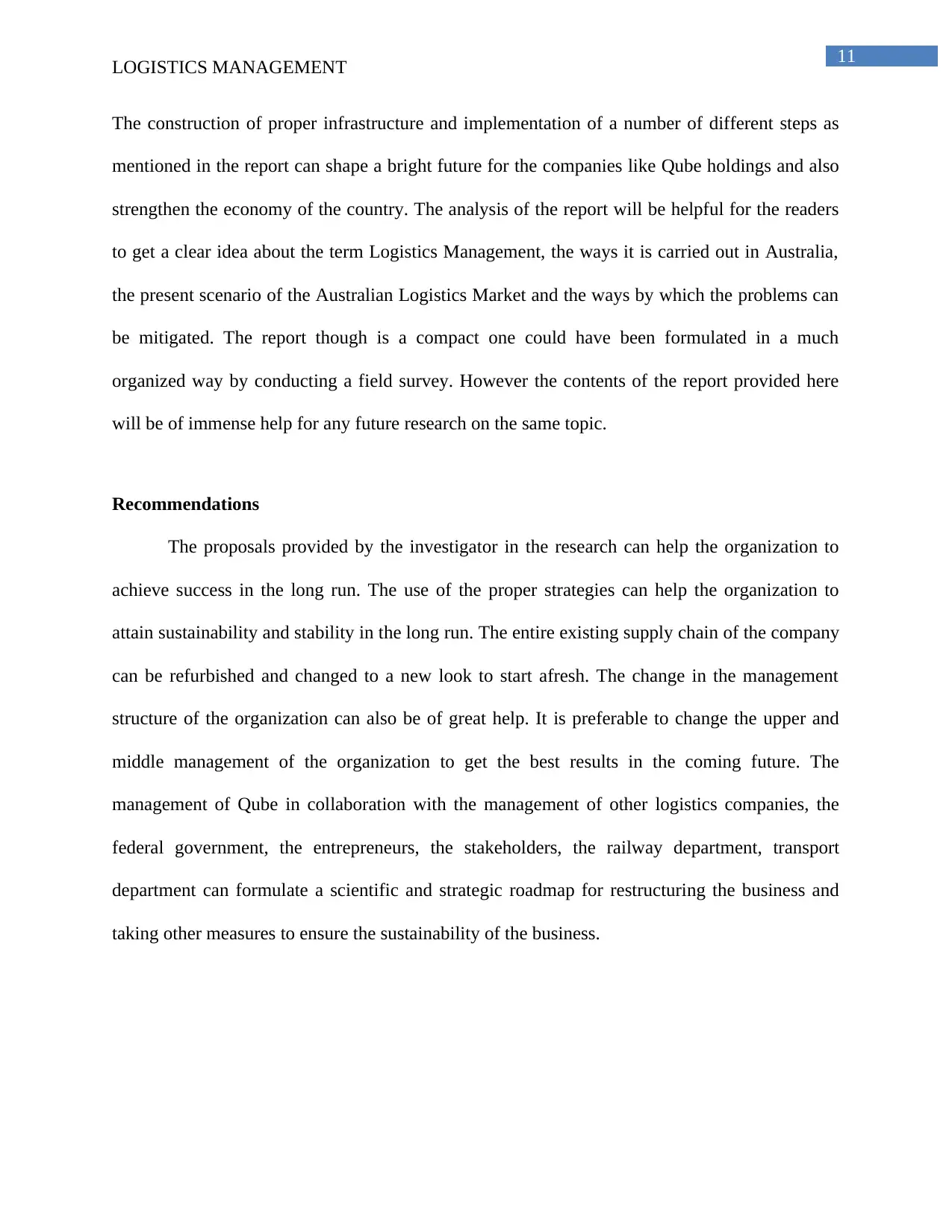
11
LOGISTICS MANAGEMENT
The construction of proper infrastructure and implementation of a number of different steps as
mentioned in the report can shape a bright future for the companies like Qube holdings and also
strengthen the economy of the country. The analysis of the report will be helpful for the readers
to get a clear idea about the term Logistics Management, the ways it is carried out in Australia,
the present scenario of the Australian Logistics Market and the ways by which the problems can
be mitigated. The report though is a compact one could have been formulated in a much
organized way by conducting a field survey. However the contents of the report provided here
will be of immense help for any future research on the same topic.
Recommendations
The proposals provided by the investigator in the research can help the organization to
achieve success in the long run. The use of the proper strategies can help the organization to
attain sustainability and stability in the long run. The entire existing supply chain of the company
can be refurbished and changed to a new look to start afresh. The change in the management
structure of the organization can also be of great help. It is preferable to change the upper and
middle management of the organization to get the best results in the coming future. The
management of Qube in collaboration with the management of other logistics companies, the
federal government, the entrepreneurs, the stakeholders, the railway department, transport
department can formulate a scientific and strategic roadmap for restructuring the business and
taking other measures to ensure the sustainability of the business.
LOGISTICS MANAGEMENT
The construction of proper infrastructure and implementation of a number of different steps as
mentioned in the report can shape a bright future for the companies like Qube holdings and also
strengthen the economy of the country. The analysis of the report will be helpful for the readers
to get a clear idea about the term Logistics Management, the ways it is carried out in Australia,
the present scenario of the Australian Logistics Market and the ways by which the problems can
be mitigated. The report though is a compact one could have been formulated in a much
organized way by conducting a field survey. However the contents of the report provided here
will be of immense help for any future research on the same topic.
Recommendations
The proposals provided by the investigator in the research can help the organization to
achieve success in the long run. The use of the proper strategies can help the organization to
attain sustainability and stability in the long run. The entire existing supply chain of the company
can be refurbished and changed to a new look to start afresh. The change in the management
structure of the organization can also be of great help. It is preferable to change the upper and
middle management of the organization to get the best results in the coming future. The
management of Qube in collaboration with the management of other logistics companies, the
federal government, the entrepreneurs, the stakeholders, the railway department, transport
department can formulate a scientific and strategic roadmap for restructuring the business and
taking other measures to ensure the sustainability of the business.
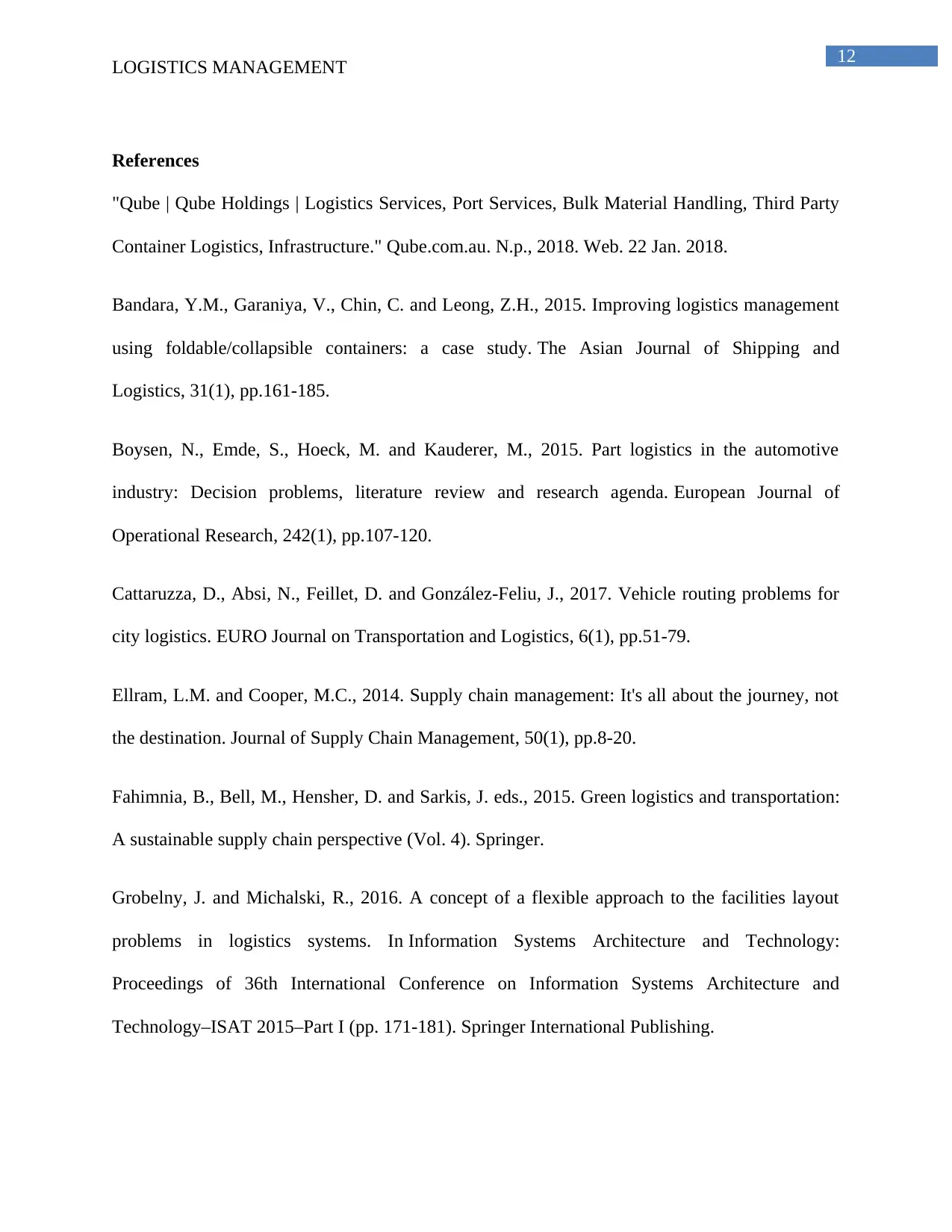
12
LOGISTICS MANAGEMENT
References
"Qube | Qube Holdings | Logistics Services, Port Services, Bulk Material Handling, Third Party
Container Logistics, Infrastructure." Qube.com.au. N.p., 2018. Web. 22 Jan. 2018.
Bandara, Y.M., Garaniya, V., Chin, C. and Leong, Z.H., 2015. Improving logistics management
using foldable/collapsible containers: a case study. The Asian Journal of Shipping and
Logistics, 31(1), pp.161-185.
Boysen, N., Emde, S., Hoeck, M. and Kauderer, M., 2015. Part logistics in the automotive
industry: Decision problems, literature review and research agenda. European Journal of
Operational Research, 242(1), pp.107-120.
Cattaruzza, D., Absi, N., Feillet, D. and González-Feliu, J., 2017. Vehicle routing problems for
city logistics. EURO Journal on Transportation and Logistics, 6(1), pp.51-79.
Ellram, L.M. and Cooper, M.C., 2014. Supply chain management: It's all about the journey, not
the destination. Journal of Supply Chain Management, 50(1), pp.8-20.
Fahimnia, B., Bell, M., Hensher, D. and Sarkis, J. eds., 2015. Green logistics and transportation:
A sustainable supply chain perspective (Vol. 4). Springer.
Grobelny, J. and Michalski, R., 2016. A concept of a flexible approach to the facilities layout
problems in logistics systems. In Information Systems Architecture and Technology:
Proceedings of 36th International Conference on Information Systems Architecture and
Technology–ISAT 2015–Part I (pp. 171-181). Springer International Publishing.
LOGISTICS MANAGEMENT
References
"Qube | Qube Holdings | Logistics Services, Port Services, Bulk Material Handling, Third Party
Container Logistics, Infrastructure." Qube.com.au. N.p., 2018. Web. 22 Jan. 2018.
Bandara, Y.M., Garaniya, V., Chin, C. and Leong, Z.H., 2015. Improving logistics management
using foldable/collapsible containers: a case study. The Asian Journal of Shipping and
Logistics, 31(1), pp.161-185.
Boysen, N., Emde, S., Hoeck, M. and Kauderer, M., 2015. Part logistics in the automotive
industry: Decision problems, literature review and research agenda. European Journal of
Operational Research, 242(1), pp.107-120.
Cattaruzza, D., Absi, N., Feillet, D. and González-Feliu, J., 2017. Vehicle routing problems for
city logistics. EURO Journal on Transportation and Logistics, 6(1), pp.51-79.
Ellram, L.M. and Cooper, M.C., 2014. Supply chain management: It's all about the journey, not
the destination. Journal of Supply Chain Management, 50(1), pp.8-20.
Fahimnia, B., Bell, M., Hensher, D. and Sarkis, J. eds., 2015. Green logistics and transportation:
A sustainable supply chain perspective (Vol. 4). Springer.
Grobelny, J. and Michalski, R., 2016. A concept of a flexible approach to the facilities layout
problems in logistics systems. In Information Systems Architecture and Technology:
Proceedings of 36th International Conference on Information Systems Architecture and
Technology–ISAT 2015–Part I (pp. 171-181). Springer International Publishing.
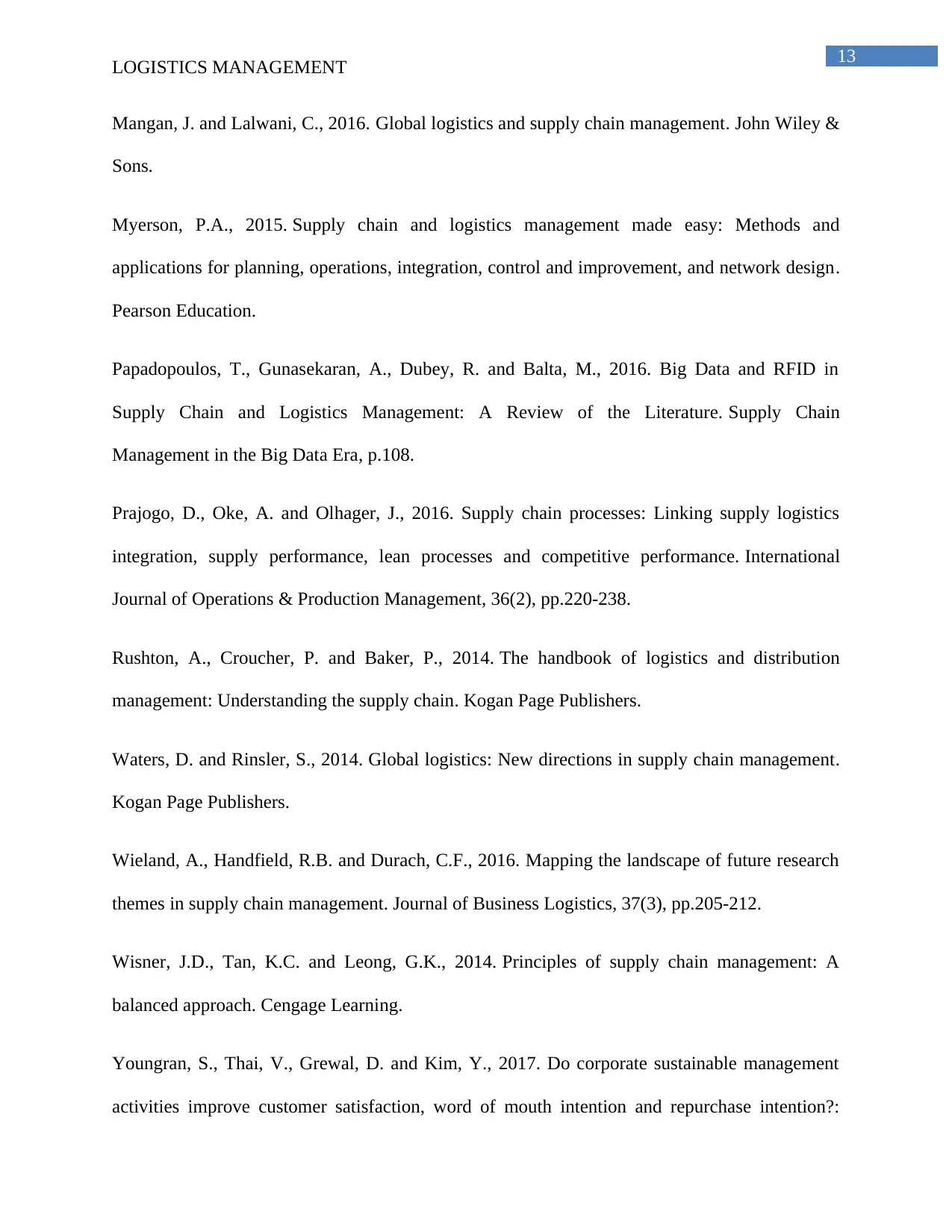
13
LOGISTICS MANAGEMENT
Mangan, J. and Lalwani, C., 2016. Global logistics and supply chain management. John Wiley &
Sons.
Myerson, P.A., 2015. Supply chain and logistics management made easy: Methods and
applications for planning, operations, integration, control and improvement, and network design.
Pearson Education.
Papadopoulos, T., Gunasekaran, A., Dubey, R. and Balta, M., 2016. Big Data and RFID in
Supply Chain and Logistics Management: A Review of the Literature. Supply Chain
Management in the Big Data Era, p.108.
Prajogo, D., Oke, A. and Olhager, J., 2016. Supply chain processes: Linking supply logistics
integration, supply performance, lean processes and competitive performance. International
Journal of Operations & Production Management, 36(2), pp.220-238.
Rushton, A., Croucher, P. and Baker, P., 2014. The handbook of logistics and distribution
management: Understanding the supply chain. Kogan Page Publishers.
Waters, D. and Rinsler, S., 2014. Global logistics: New directions in supply chain management.
Kogan Page Publishers.
Wieland, A., Handfield, R.B. and Durach, C.F., 2016. Mapping the landscape of future research
themes in supply chain management. Journal of Business Logistics, 37(3), pp.205-212.
Wisner, J.D., Tan, K.C. and Leong, G.K., 2014. Principles of supply chain management: A
balanced approach. Cengage Learning.
Youngran, S., Thai, V., Grewal, D. and Kim, Y., 2017. Do corporate sustainable management
activities improve customer satisfaction, word of mouth intention and repurchase intention?:
LOGISTICS MANAGEMENT
Mangan, J. and Lalwani, C., 2016. Global logistics and supply chain management. John Wiley &
Sons.
Myerson, P.A., 2015. Supply chain and logistics management made easy: Methods and
applications for planning, operations, integration, control and improvement, and network design.
Pearson Education.
Papadopoulos, T., Gunasekaran, A., Dubey, R. and Balta, M., 2016. Big Data and RFID in
Supply Chain and Logistics Management: A Review of the Literature. Supply Chain
Management in the Big Data Era, p.108.
Prajogo, D., Oke, A. and Olhager, J., 2016. Supply chain processes: Linking supply logistics
integration, supply performance, lean processes and competitive performance. International
Journal of Operations & Production Management, 36(2), pp.220-238.
Rushton, A., Croucher, P. and Baker, P., 2014. The handbook of logistics and distribution
management: Understanding the supply chain. Kogan Page Publishers.
Waters, D. and Rinsler, S., 2014. Global logistics: New directions in supply chain management.
Kogan Page Publishers.
Wieland, A., Handfield, R.B. and Durach, C.F., 2016. Mapping the landscape of future research
themes in supply chain management. Journal of Business Logistics, 37(3), pp.205-212.
Wisner, J.D., Tan, K.C. and Leong, G.K., 2014. Principles of supply chain management: A
balanced approach. Cengage Learning.
Youngran, S., Thai, V., Grewal, D. and Kim, Y., 2017. Do corporate sustainable management
activities improve customer satisfaction, word of mouth intention and repurchase intention?:
Paraphrase This Document
Need a fresh take? Get an instant paraphrase of this document with our AI Paraphraser

14
LOGISTICS MANAGEMENT
Empirical evidence from the shipping industry. International Journal of Logistics
Management, 28(2), pp.555-570.
LOGISTICS MANAGEMENT
Empirical evidence from the shipping industry. International Journal of Logistics
Management, 28(2), pp.555-570.
1 out of 14
Related Documents
Your All-in-One AI-Powered Toolkit for Academic Success.
+13062052269
info@desklib.com
Available 24*7 on WhatsApp / Email
![[object Object]](/_next/static/media/star-bottom.7253800d.svg)
Unlock your academic potential
© 2024 | Zucol Services PVT LTD | All rights reserved.





